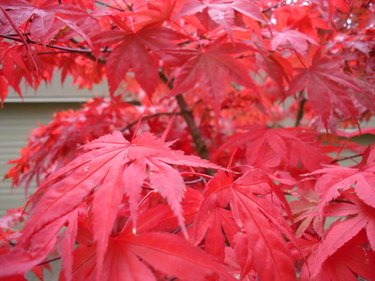
While native to Japan, many people choose to grow Japanese maple trees in Texas because of their striking foliage. With hundreds of cultivars and variations available, there is likely a Japanese maple that can thrive in your yard in Dallas, Texas. When selecting a Japanese maple, you must consider the hardiness zone in addition to size and form.
Understanding USDA Hardiness Zones
Video of the Day
Many factors are worth considering when selecting the type of Japanese maple to plant in your yard; however, the most critical is the hardiness zone. Hardiness zones divide the country into 10-degree-Fahrenheit regions based on the average annual lowest winter temperatures. Known as the USDA hardiness zones, the map helps inform which plants can grow where.
Video of the Day
The state of Texas has eight hardiness zones, ranging from zones 6a to 9b, meaning the lowest winter temperatures in Texas average around -10 to -5 degrees Fahrenheit. In contrast, the warmer regions' lowest average winter temperatures average around 25 to 30 degrees Fahrenheit. While Texas covers a large span of hardiness zones, Dallas has much less variation, with zones ranging from 7b to 8a. When selecting a Japanese maple to grow in your yard in Dallas, the tree must be able to withstand winter temperatures between -15 and 15 degrees Fahrenheit.
If you're unsure of a Japanese maple's hardiness zone, the plant's label will usually indicate this zone, or someone at the plant nursery can tell you.
How Fast Do Japanese Maples Grow?
When looking to grow a Japanese maple in Texas, you may be wondering how fast they grow. When you know a plant's growth rate, you can make an informed decision on which stage of growth for Japanese maples is best for your needs. For example, a young Japanese maple might not be ideal for an inexperienced gardener or someone who wants to enjoy the mature tree's foliage right away.
While there are some discrepancies among the different types of maples, most Japanese maples have a slow to moderate growth rate. Generally, the growth rate is faster when the Japanese maple is young and then slows by a significant amount as it matures. A Japanese maple tree will grow around 1 to 2 feet a year. If you're looking for mature Japanese maples but are unable to locate one in your area, a variety with a faster-than-average growth rate may suit your needs, such as Beni-Otake Japanese maple.
Japanese Maples That Can Grow in Dallas
Once you have decided to plant a Japanese maple in Texas, you will have to determine which varieties are compatible with your hardiness zone. Most Japanese maples require a hardiness zone between 5 and 8, meaning that growing certain varieties of Japanese maple trees in Texas won't be feasible. However, certain varieties can grow in warmer zones, but they may experience leaf scorch and will require protection from the afternoon sun.
In addition to hardiness zones, you should consider the space available for the maple and the desired foliage color. If you're looking to plant in a container or small space, the Shaina, Kagiri Nishiki and Red Dragon varieties can grow in zones 5-8, while the Velvet Viking variety can grow in zones 4-9. The Shishigashira, Crimson Queen and Emperor I varieties all have a hardiness zone of 5-8, making it possible for them to grow in Dallas, Texas. These varieties are best suited to locations where there is enough open space to thrive and grow.